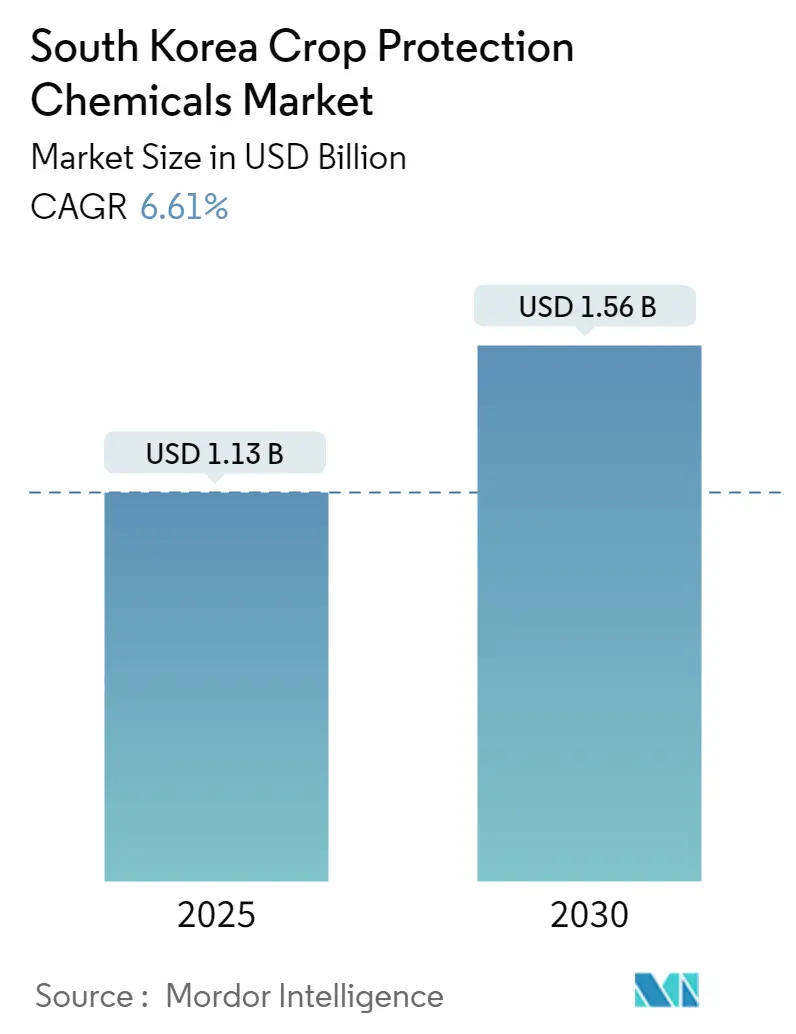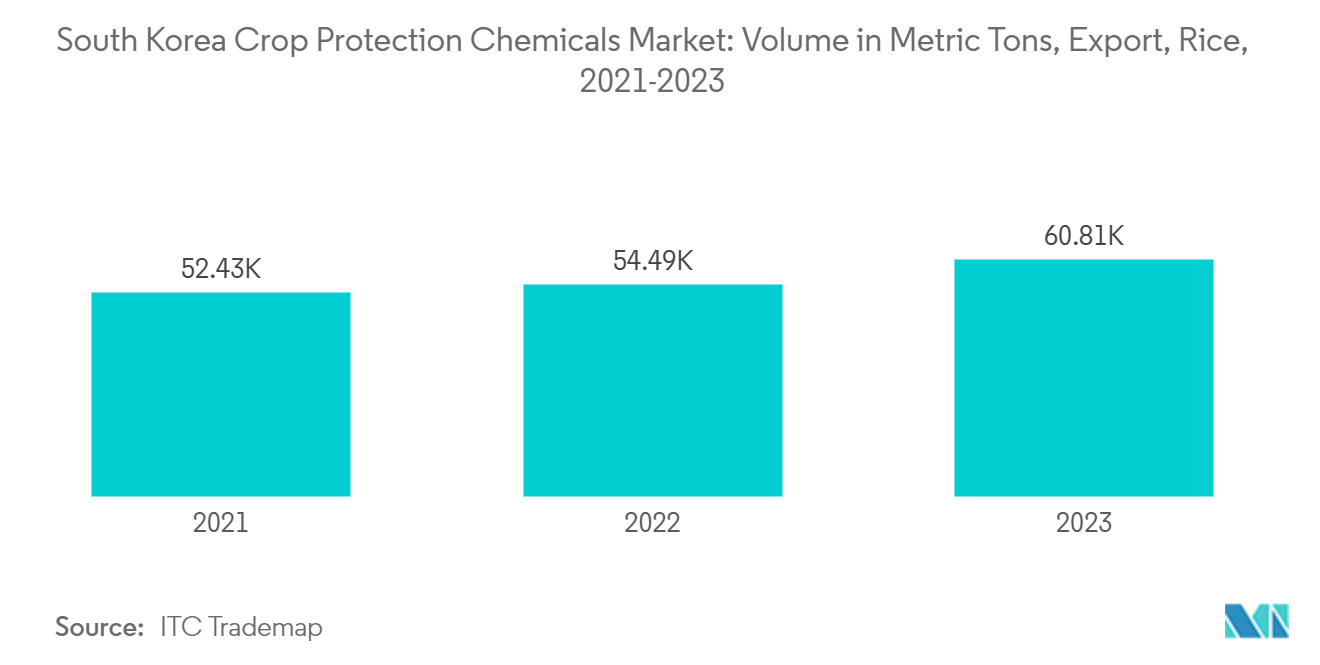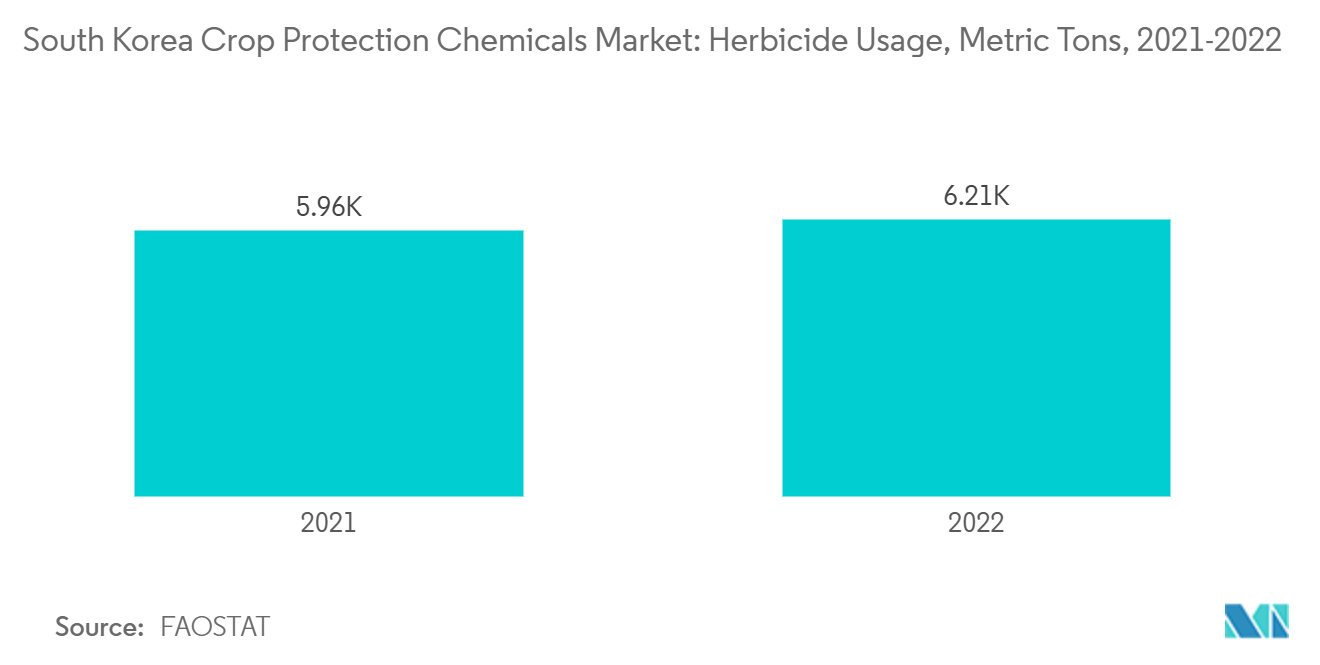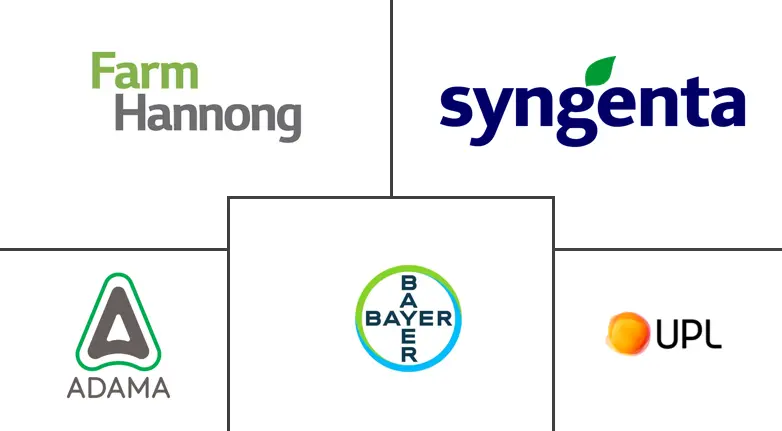
South Korea Crop Protection Chemicals Market Analysis by Mordor Intelligence
The South Korea Crop Protection Chemicals Market size is estimated at USD 1.13 billion in 2025, and is expected to reach USD 1.56 billion by 2030, at a CAGR of 6.61% during the forecast period (2025-2030).
Rice dominates South Korean agriculture, comprising about 96% of total grain production and over 40% of farm income. In 2022, South Korea produced 5.0 metric tons of rice, according to FAOSTAT. The importance of rice to the national economy and agricultural sector necessitates heavy reliance on crop protection chemicals to safeguard against pests, diseases, and weeds. Efficient use of pesticides and herbicides is crucial for maintaining high rice yields.
South Korea's mountainous terrain limits arable land to less than 22% of its total area. This scarcity pressures farmers to maximize crop productivity per unit of land. While rice is predominant, other crops such as vegetables, soybeans, oilseeds, and fruits also require significant crop protection chemicals to optimize yields on limited available land.
The South Korean government has introduced robust policies to support agricultural productivity. For instance, on 17 January 2024, the government announced a USD 230 million increase in the 2024 budget for the agricultural direct payment system, raising the total to USD 2.30 billion from USD 2.08 billion in 2023. The agricultural direct payment system incentivizes farmers to diversify crops and optimize land use. Under this system, farmers are encouraged to convert rice paddies to cultivate crops such as forage crops, vegetables (like alfalfa and clover), barley, wheat, and rye. Farmers can receive payments between USD 743 to USD 1,486 per hectare for such conversions. These payments help mitigate risks and support farmers in diversifying their production, potentially increasing the use of crop protection chemicals as they adopt new crops with different pest management requirements. With strong government support through direct payment systems and emphasis on maximizing productivity per unit area, the demand for efficient and effective crop protection solutions in South Korea is anticipaed to grow.
South Korea Crop Protection Chemicals Market Trends and Insights
Disease and pests Threat Driving the Demand for Pesticides in Rice Crop
Rice production is a cornerstone of South Korea's agricultural industry and a primary driver of the country's crop protection chemicals market. As the crop with the highest proportion of agricultural output, rice is particularly vulnerable to pests and diseases. Without the application of fungicides and insecticides, rice yield losses due to insects and diseases can reach 16%.
Rice blast disease, a severe fungal infection, poses one of the most significant threats to rice production in South Korea. This disease can substantially reduce yields, with global estimates indicating annual losses of 10–30%. In South Korea, effective control of rice blast is crucial for maintaining high yields, making fungicides an essential component of rice production practices.
The susceptibility of rice to pests and diseases, especially rice blast, highlights the importance of crop protection chemicals in South Korea. These products are vital for sustaining rice yields and maintaining the economic stability of the agricultural sector.
In addition, rising export demand is further driving the need for crop protection chemicals. Ensuring crops are protected from pests and diseases while maintaining high quality standards is essential to improving productivity. According to ITC Trade Map, South Korea’s rice exports increased from 54.5 thousand metric tons in 2022 to 60.1 thousand metric tons in 2023, highlighting the growing importance of protecting rice crops to meet both domestic and international demand.

Growing Herbicides Consumption
Pesticide use in South Korea is experiencing steady growth, with herbicides constituting the largest portion of pesticide consumption. The country's limited arable land and the need to maximize agricultural productivity have made herbicide use essential for weed control, which significantly impacts crop yields. FAOSTAT data shows that pesticide usage increased from 16,745 metric tons in 2019 to 19,882 metric tons in 2022. During the same period, herbicide usage rose by 15.4% to 6,207 metric tons.
Herbicides play a crucial role in rice production, which is the dominant crop in South Korea's agricultural sector. They are vital for minimizing weed competition and ensuring optimal growth conditions. Other crops such as vegetables, soybeans, and fruits also rely heavily on herbicides for effective weed management. The increasing emphasis on maximizing farming efficiency, coupled with advancements in herbicide technology and formulation, continues to drive the expanded use of these chemicals across South Korea's agricultural sectors.

Competitive Landscape
The South Korean crop protection chemicals market is fairly consolidated, with a few companies holding the majority of the shares in the market, including Syngenta, Bayer AG Ltd, UPL Ltd, and Adama Agricultural Solutions.. In the fast-growing market, companies are competing based on product quality or product promotion and making other strategic moves to acquire greater market share and expand their acquired market size.
South Korea Crop Protection Chemicals Industry Leaders
Syngenta
Bayer Korea Ltd.
UPL
Adama Korea Co., Ltd.
Farm Hannong
- *Disclaimer: Major Players sorted in no particular order
Recent Industry Developments
- May 2023: Syngenta Crop Protection and FMC Corporation have entered into an agreement to introduce a new herbicide product for controlling grass weeds in rice across Asia. The active ingredient, Tetflupyrolimet, was discovered and developed by FMC with Syngenta's support for rice applications. This herbicide represents the first major product with a novel mode of action (DHODH - HRAC Group 28). As per the agreement, Syngenta will market products containing Tetflupyrolimet mixtures for rice in India, Vietnam, Indonesia, Japan, and South Korea.
- March 2023: Corteva Agriscience has announced the commercial launch of Adavelt active, following recent product registrations in Australia, Canada, and South Korea. Adavelt Active is a new fungicide that employs a novel mode of action to protect crops against a wide range of yield-impacting diseases.
- January 2021: Syngenta launched a crop protection chemical called "APIRO" for consistent control of annual grasses in paddy rice, with the flexibility to apply from pre-emergence up to the 3-leaf stage.
South Korea Crop Protection Chemicals Market Report Scope
Crop protection chemicals constitute a class of agrochemicals used to prevent crop destruction by insect pests, diseases, weeds, and other pests. The South Korean crop protection chemicals market is segmented by chemistry (into synthetic crop protection chemicals and biopesticides), product type (into herbicides, insecticides, fungicides, and other crop protection chemicals), and crop type (into grains and cereals, pulses, and oilseeds, commercial crops, fruits, and vegetables, and other crop types). The report offers market size and forecasts in terms of value in USD and Volume in metric tons for all the above segments.
| Synthetic Crop Protection Chemicals |
| Biopesticides |
| Herbicides |
| Insecticides |
| Fungicides |
| Other Crop Protection Chemicals |
| Grains and Cereals | Rice |
| Barley | |
| Other Grains | |
| Pulses and Oilseeds | |
| Commercial Crops | Cotton |
| Other Crops | |
| Fruits and Vegetables | |
| Other Crop Types |
| Chemistry | Synthetic Crop Protection Chemicals | |
| Biopesticides | ||
| Product Type | Herbicides | |
| Insecticides | ||
| Fungicides | ||
| Other Crop Protection Chemicals | ||
| Crop Type | Grains and Cereals | Rice |
| Barley | ||
| Other Grains | ||
| Pulses and Oilseeds | ||
| Commercial Crops | Cotton | |
| Other Crops | ||
| Fruits and Vegetables | ||
| Other Crop Types | ||
Key Questions Answered in the Report
How big is the South Korea Crop Protection Chemicals Market?
The South Korea Crop Protection Chemicals Market size is expected to reach USD 1.13 billion in 2025 and grow at a CAGR of 6.61% to reach USD 1.56 billion by 2030.
What is the current South Korea Crop Protection Chemicals Market size?
In 2025, the South Korea Crop Protection Chemicals Market size is expected to reach USD 1.13 billion.
Who are the key players in South Korea Crop Protection Chemicals Market?
Syngenta, Bayer Korea Ltd., UPL, Adama Korea Co., Ltd. and Farm Hannong are the major companies operating in the South Korea Crop Protection Chemicals Market.
What years does this South Korea Crop Protection Chemicals Market cover, and what was the market size in 2024?
In 2024, the South Korea Crop Protection Chemicals Market size was estimated at USD 1.06 billion. The report covers the South Korea Crop Protection Chemicals Market historical market size for years: 2019, 2020, 2021, 2022, 2023 and 2024. The report also forecasts the South Korea Crop Protection Chemicals Market size for years: 2025, 2026, 2027, 2028, 2029 and 2030.
Page last updated on:
South Korea Crop Protection Chemicals Market Report
Statistics for the 2025 South Korea Crop Protection Chemicals market share, size and revenue growth rate, created by Mordor Intelligence™ Industry Reports. South Korea Crop Protection Chemicals analysis includes a market forecast outlook for 2025 to 2030 and historical overview. Get a sample of this industry analysis as a free report PDF download.



